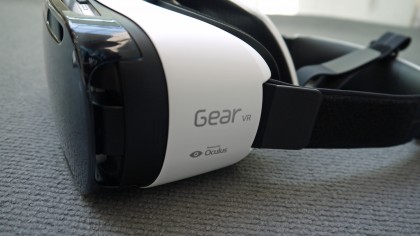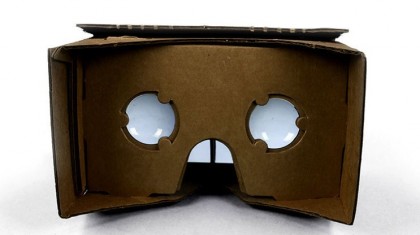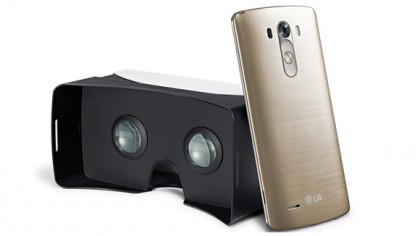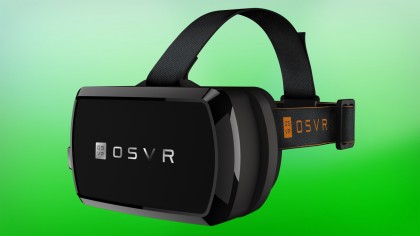The VR race: What you need to know about Oculus Rift, HTC Vive and more
Sleek mobile integration: Samsung's Gear VR
Google may want to bring low-cost VR to the masses, but Samsung's Gear VR headset makes mobile virtual reality look sleek and seamless with its dedicated platform. It's also about to get better.
The recent Oculus Connect 2 conference revealed a brand new headset - the final Samsung Gear VR for consumers. It's also only priced at $99 (about £65, AU$140) and will be shipping in November of this year. While many scoff at the thought of our mobile devices as virtual reality transporters, they actually do a decent job.
The only issue with the new Gear VR? You'll need a Samsung Galaxy Note 5, S6 Edge+, S6 or S6 Edge for it to work.
The big reveal for Gear VR happened during IFA 2014. The differentiating factor for this headset is the addition of the Samsung Galaxy Note 4 - meaning Gear VR isn't a standalone device. In fact, there is a compartment at the front of the device for the handset.
Gear VR hasn't been a complete letdown and is in fact, pushing VR along quite nicely. It's helping spawn a mobile VR movement of sorts and with the help of Oculus, the tech seems to sound so far but devs need to step it up and provide more VR experiences.
During MWC 2015, Samsung announced yet another Gear VR making it two mobile VR devices from the company and Oculus. Rather than using a Note 4, the newest Gear VR remains an Innovator's Edition that will harness power from the Samsung Galaxy S6 and the Galaxy S6 Edge - devices supposedly even better than the Note 4 version of the untethered headset.

Potential Competitive Edge: Like Sony, Samsung is capable of putting an enormous amount of funding behind this project. In recent years, the company's smartphones have garnered an enormous base of loyal followers to rival (or even surpass) Apple's iPhone. The Gear VR is also the first virtual reality device to make it to market - plus the first VR mobile device to boot - and it isn't completely horrible.
Sign up for breaking news, reviews, opinion, top tech deals, and more.
Despite being the little cousin to Oculus Rift, the Gear VR and all its iterations may win the hearts of the public purely because of its portability.
DIY virtual reality: Google Cardboard
While many VR companies look to create all-inclusive headsets that use their own operating systems, tech giant Google has gone a decidedly different route. The company's developers wanted to create a way for people to enjoy virtual reality that didn't involve expensive equipment.
What they came up with is "I/O Cardboard" - a cut-and-fold VR headset that integrates with any Android phone and its corresponding Cardboard app. The strategy takes aim at democratizing the VR movement by putting headsets into the hands of consumers and developers who may otherwise consider products like these well out of their price range.
Cardboard is an open-source project, which leaves the development field wide open for whoever thinks they can improve on what Google has started. The full design specs to create a Cardboard prototype are available through Google for free.
At the latest IO event, Google announced a new Cardboard - one that's even simpler to make if you can believe that. The app is also officially available for iOS users. Various Cardboard models now allow larger phones to fit as well.

Potential Competitive Edge: Google's R&D department is massive, and the company is well-known for its clever designs. It also isn't afraid to take risks in pricing to get its foot in the door against much higher-priced devices (just look at the Chromecast). Additionally, some industry observers have speculated that this could lead to some sort of VR integration with Google Glass further down the road.
It seems unlikely, though, that Cardboard will be able to compete directly with some of the more advanced and full-featured headsets in the market. Google also has a pretty significant graveyard of abandoned projects, and only time will tell if Cardboard's headstone will be among them.
At the moment, Cardboard is still managing to stay afloat because of its low price, simple design and portability. Its allowance of iOS devices also allows greater accessibility for people curious about trying VR.
Google teams up with LG: VR for G3
Little is known right now about VR for G3 except that Google software will be used to create a virtual reality environment. The design of VR for G3 is based on the blueprint for Google Cardboard. VR for G3 is also reminiscent of Samsung Gear VR since it uses an LG G3 phone to provide the visuals and sound.
It will also feature a special "neodymium ring magnet" that uses the phone's gyroscope to let users control it without touching the display.

Potential Competitive Edge: Pricing is key here. If Galaxy Note 4 owners are willing to buy the Gear VR, G3 owners may be drawn to the VR for G3. But phone-specific tethering could also kill both VR devices. It's also unclear how well the G3 VR works at this point but the power of Google may help the tech succeed.
Then again, the hype over Google Glass didn't do it any good since it's been shelved for the unforeseeable future.
Seeking standards: Razer OSVR
OSVR is Razer's answer to the Wild West of virtual reality. The company created a new platform called Open-Source Virtual Reality (OSVR) in an attempt to unify those in the VR field, and people who want a piece of the VR pie. Essentially, the open platform is free and will allow third parties to design and build their own apps and hardware across any operating systems, including Windows, Android and Linux.
The OSVR is available limitedly to developers now, with public access arriving soon, with preorders happening in October 2015.
But that's not all from Razer. The company also announced a VR head mounted display its calling the OSVR Hacker Dev Kit. The HMD isn't close to being ready for consumers from our hands on during CES, but the prototype promises to be modular and like the software, completely open.

Potential Competitive Edge: If Google is trying DIY VR, Razer is taking it to another level. The company promises it will be modular and like the software, completely open. Design schematics for the hardware will even be available to print out on 3D printers. But from our hands on during CES, the HMD is far from ready for consumers and is still very much a prototype right now.
Will Razer at least win in terms of standardization? It seems like more companies are jumping on board the OSVR train. If hardware won't win, the software and platform may come out on top.
The final verdict? Still unclear
So do any of these companies truly have a decisive advantage? To some extent, arguments could be made for most of these headsets. Oculus currently is still considered the industry leader and now that it's closer to release - with its own set of peripherals - it has set the bar even higher.
At this point, Sony's Morpheus appears to be Oculus's strongest competition - and though it's not virtual reality, the Microsoft HoloLens is certainly a big player.
It's also worthwhile noting that Sony and Samsung both are extremely well-funded where Sony in particular, can leverage its PS4 consumer base to hit the ground running with its headset. Microsoft, of course, possesses a similar advantage with its Xbox One fans.
While its headset's functionality likely will be used with smartphones, Samsung does have a wide app and gaming environment to help bolster its offering. There may also be other unexplored advantages to coupling a 3D experience with the convenience and portability of a smartphone. Google Cardboard, too, could find itself benefitting from this paradigm, with VR for G3 and even with the Project Tango tablet.
In the end, the future of VR headsets will inevitably revolve around these devices' ability to make gamers (and then, presumably, the wider non-gaming market) want to use them. That means the goal is making them affordable, wearable and better at creating a compelling graphical experience than the current model. In either case, the public will find out who truly has the upper hand in a matter of months.
- 1
- 2
Current page: The VR race: Samsung, Google and Razer
Prev Page The VR race: Valve, Sony, Microsoft and Oculus